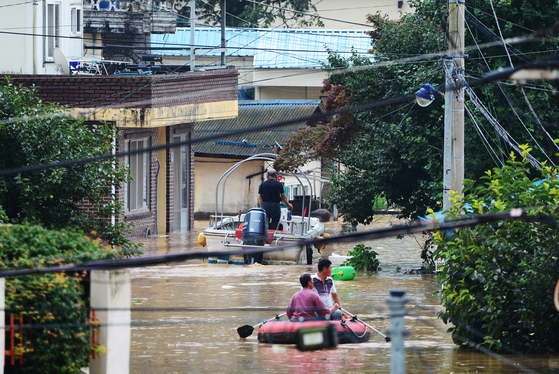
On the afternoon of August 8, last year, the village was flooded by the flood of the Seomjin River near Hadong-eup, Hadong-gun, Gyeongnam, and residents are moving by rubber boat. Newsis
Last year, it was found that the worst economic damage was over 1.2 trillion won due to the longest rainy season and typhoon.
The Meteorological Administration, jointly with relevant ministries such as the Office of the State Affairs Control Office, the Ministry of Public Administration and Security, and the Ministry of Environment, published the ‘2020 Abnormal Climate Report’, a compilation of the current situation and social impact of the abnormal climate that occurred in 2020.
According to the report, the longest rainy season last year, the effects of consecutive typhoons from August to September, and unusual abnormal temperatures during the summer and winter months caused exceptional social and economic damage.
In particular, typhoons and heavy rains resulted in damage to assets of 1.25 trillion won and damage to 46 people. This is more than three times the annual average damage in the last 10 years (2010-2019) (388.3 billion won in property, 14 people).
In addition, 6175 cases (1343 ha) of landslides occurred, the third largest in history since 1976. In the energy sector, power outages occurred on 298,818 units due to typhoon’Mysak’, which is twice the level of typhoon’Lingling’ (16,1646 units) in 2019, when the damage was the most.

Distribution of abnormal climate events in 2020. Provided by the Meteorological Agency
In the last winter, abnormal high temperatures continued across the country, and the temperature in January was the warmest since 1973. Due to the effect of abnormal high temperature, the overwintering of pests did not die, and in the summer, large insects such as stick insects and gypsy moth appeared. In particular, leaf damage (damage by eating the leaves of plants) occurred in an area of 6183ha, such as the large-scale forest turned red due to the gypsy moth.
Meanwhile, due to the warm winter, the damage caused by heavy snow and cold waves decreased by 34% and 81.2%, respectively, from the 5-year average to 303 people with cold diseases and 2 people who died.
Meteorological Administration Director Park Gwang-seok said, “2020 was a year in which we were able to feel the seriousness of climate change such as abnormal temperatures, long rainy seasons, and consecutive typhoons, and once again realized the importance of the national goal of carbon neutrality and the need for active action to implement it.” He said, “I look forward to the publication of this report on climate change as a basis for responding to climate change.”
Reporter Chun Kwon-pil [email protected]
